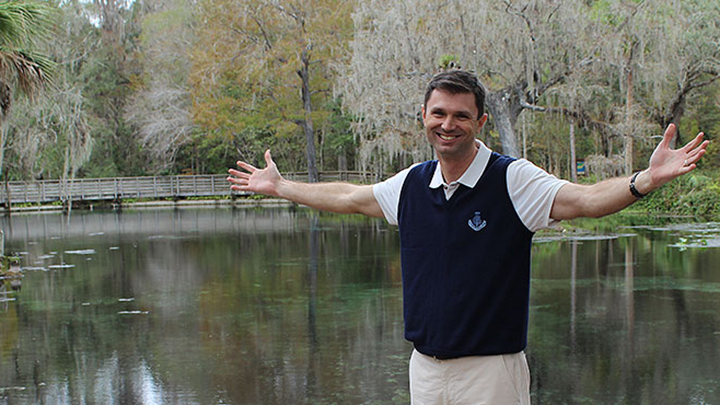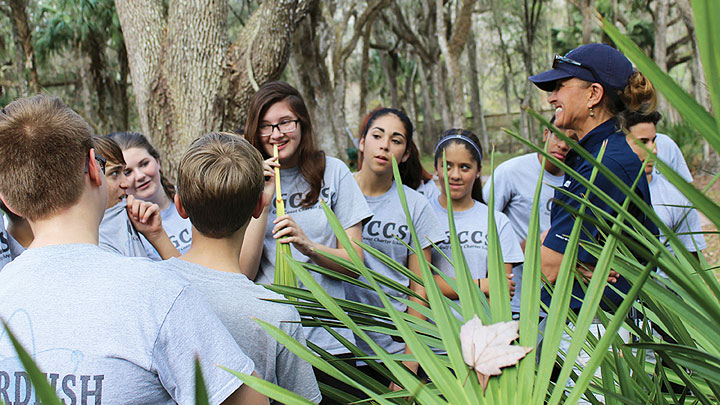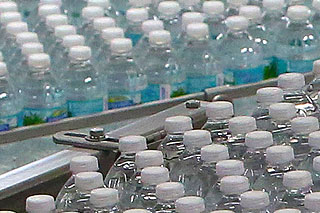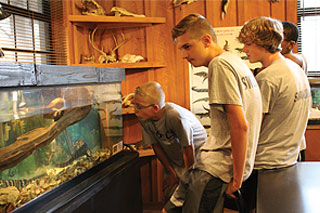Current Features
Florida's Buried Treasure
By Penny Carnathan '82

Twenty-two eighth-graders have just gotten "lost" in the Florida wilderness. Working in pairs, they have two minutes to set up transpiration bags to coax drinking water from the plants around them. At "GO!," they take off in all directions, racing toward native magnolias, saw palmettos and oaks with their empty gallon-sized Ziploc baggies.
"No running! You are in survival mode!" calls "Miss Vicki" Mohr, their survival instructor at Crystal Springs Preserve, a 530-acre nature sanctuary next to Two Rivers Ranch in Pasco County. "If you run, you sweat; you lose energy; you get hungry!" Later she'll show them how they can eat the Spanish moss hanging from trees overhead, but that's a light snack at best.
During their day with Miss Vicki, the Gulf Coast Academy of Science and Technology students from Spring Hill, Fla., hunt for venomous snakes (the plastic variety), discuss ways to fish without a hook and line, and build wind-proof, rain-proof shelters from palmetto fronds. In past years, these same students netted crawfish and marine microorganisms for a biodiversity survey at the preserve and explored the life cycle of the clear spring water bubbling up from dozens of fissures in the limestone below.

"I just love being out here. I don't get the chance to do this where I live. I don't have the springs and the animals and the trees," says Monica Steele, 13. After attending the programs at Crystal Springs, "I feel more connected; more interested in going outside in nature."
That's exactly what the creators of the non-profit Crystal Springs Foundation intend, says board member Michael Babb, MBA '02, president of Two Rivers Ranch. Youngsters who enjoy woods and wildlife will be more likely to protect them – and the water that feeds them. So the foundation offers a full menu of K-12 environmental courses, all tied to National Science Education Standards, at its world-class education center. Groups pay a flat $25 reservation fee to participate.
"We're booked solid," Babb says.
The school, which also offers virtual programs to students around the world and a traveling interactive learning lab, takes the battle to save Florida's vanishing freshwater springs to the next level – and the next generation. Two decades ago, the state had more than 1,000 springs, the highest concentration in the world. Today, they number 600 to 900, with many survivors polluted by nitrates. Crystal Springs stands out as a success story.
"Crystal Springs Preserve is an excellent example of how a privately held natural resource can be restored and protected, while also providing commercial benefits," says Babb, a board member and past chair of the Southwest Florida Water Management District (Swiftmud), the agency responsible for protecting water resources in more than 10 counties from Levy to Charlotte.

Crystal Springs is a source of Zephyrhills Natural Spring Water. About 2 percent of the spring's total 30 million-gallons-a-day discharge gets bottled and sold by Nestle Waters, making water, along with timber and cattle, the 14,000-acre ranch's primary commodities. The largest undeveloped tract of land in Hillsborough County, the ranch stretches north to Hernando County.
"So much of our sensitive lands are managed by government entities, like Swiftmud, but they're usually better managed in private hands," Babb says. "Two Rivers Ranch has been owned by the Bob Thomas family for four generations. They love the land; it's in their DNA. And when you rely on a natural resource for income, you're going to do everything you can to protect it."
Florida's crystal-clear springs turn streams into rivers and have fed people, woodlands and wildlife for thousands of years. They bubble up from the Floridan Aquifer, the porous limestone bedrock that lies beneath the state and holds a vast river of groundwater in its cavities and crevices. Where the aquifer meets the Earth's surface, the water springs forth, forced up and out by the high pressure below.
But in recent decades, some springs have dried up or grown sluggish because of excessive groundwater pumping to meet Florida's water needs. Many have been polluted by nitrates from fertilizer runoff, septic systems and animal waste, an especially ominous development. Tainted spring water indicates the groundwater that supplies 90 percent of Florida's drinking water has been polluted as well. Last spring, the state guaranteed $50 million a year toward restoring and protecting our springs.
At Crystal Springs, that work has been done privately.
"Twenty years ago, Crystal Springs was a public swimming hole. There were beer cans and trash all over, and the vegetation near the spring pond had been stripped out for a sand volleyball court," Babb says. "It was being loved to death."
Robert Thomas, whose grandfather Wayne Thomas began purchasing the Two Rivers Ranch property in 1932, had a vision for this piece of the ranch. It began with closing the swimming hole in 1996 and restoring the springs and surrounding woods to their natural state. In 2003, in partnership with Nestle, the Crystal Springs Foundation opened its educational center. Each year, 50,000 students visit.

"For some of these kids, it's their first exposure to nature," says Mohr, one of three teachers at the center. "We had a 16-year-old boy who'd never touched a frog because he thought they give you warts. He spent all afternoon playing with frogs!"
The center's programs get kids excited about nature while delivering science lessons and information that will help them become good stewards of Florida's waters.
"It's so easy for our aquifer to be polluted; the sandy soil is so permeable," says Babb, who became president of Two Rivers Ranch in 2009 after he and Thomas became friends and business associates. "We teach the kids how the aquifer gets polluted and what they can do to help prevent it. And we work with Nestle to educate everyone in this watershed: Which substances should not be allowed to leach into the groundwater? How close should livestock be allowed near water sources?"
Babb sees nothing unusual in being a businessman with a focus on education and conservation. He and his wife, April, have three young children who've spent many a weekend at the preserve.
"Sustainability is the only way to ensure our children and grandchildren have not only the water they need in the future, but also natural gems like our Florida springs. A place like this makes it easy to get kids excited about conservation.
"Water should be a passion for everyone," he says. "It's our most valuable natural resource."
For more information about the Crystal Springs Foundation's educational center, visit www.crystalspringsfoundation.org.